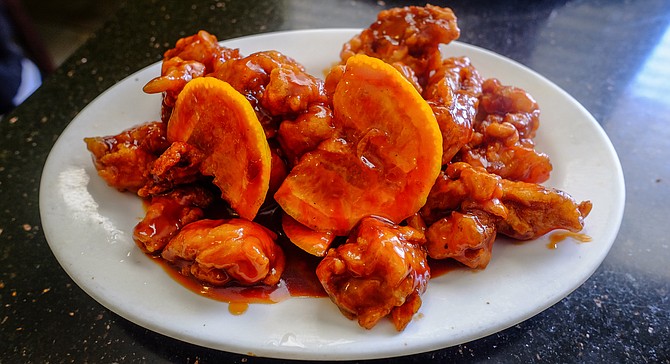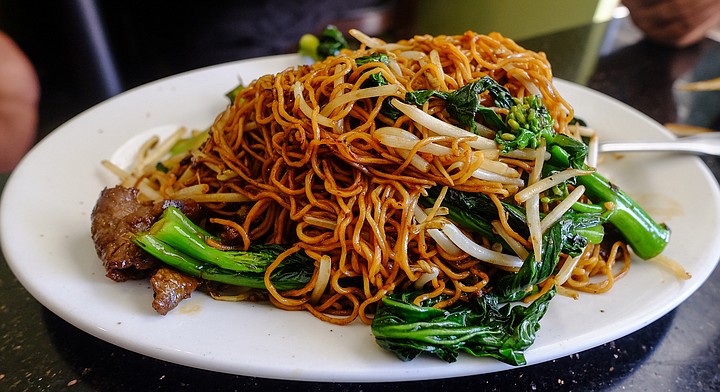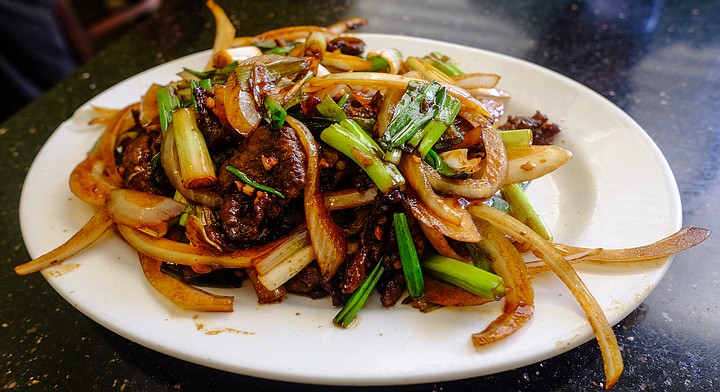 Facebook
Facebook
 X
X
 Instagram
Instagram
 TikTok
TikTok
 Youtube
Youtube

What do you order when there are 219 items on the menu?
I should probably just ask the room. It’s the Monday lunch rush at Minh Ky Restaurant, a small Chinese joint in City Heights, at the corner of a strip mall with a too small parking lot, and yet nearly every table is full.

While Minh Ky does bill itself as a Chinese restaurant, it’s located in the Little Saigon district, so in addition to English, each menu item is named in two adjacent alphabets: Chinese hanzi characters, and the Vietnamese alphabet, chữ quốc ngữ. It’s an American Chinese restaurant with Vietnamese subtitles. Speakers of all three languages are present.

Likewise, a close study of the menu reveals differences and overlap between the bordering Asian cultures, plus evidence of the Americanization of certain dishes. For example, pork and chicken dishes include recipes featuring Chinese broccoli, versus alternatives with lemongrass. There are dishes like broccoli beef and sweet and sour, which are authentically Chinese-American, born of immigrants during the California gold rush.
Much of the menu is broken up into proteins: an array of similarly constructed beef, chicken and duck, pork, and seafood dishes hovering around eight bucks a pop. There are special rice plates, and sections delineating soups, porridges, and hot pot soups, here referred to as Fire Pot. And a short list of vegetable dishes.
Four adjacent menu sections prompt a discussion at my table: what are the differences between chow mein, lo mein, chow fun, and crispy noodles?
They’re all noodle dishes, and most of them use the same thin egg (and wheat) noodles. The exception, chow fun, employs wide rice noodles. With lo mein, soft noodles are to be mixed with meat and vegetable toppings; chow mein sees them stir fried together. The meins and fun are Chinese in origin, while the crispy noodles are Vietnamese mi xao don, wherein crispy thin noodles are topped with toppings and sauce, which softens them as you eat, yielding a combination of pliability and crunch.
When I ask my server which one Minh Ky does best, she points to chow mein without hesitation. So we try it with beef and Chinese broccoli for $8.25. We decide to check out the Orange Chicken and Mongolian beef, both $7.90, and both questionably of American origin, depending who you ask.
Confused? Me too. With 219 menu items, there’s a lot to unpack. There almost has to be.
During this visit, none of the dishes wowed me, or my lunchmates. The orange chicken stood out the most, the thick citrus and spice glaze akin to BBQ sauce over chunks of fried chicken, but with an earthy undertone. The Mongolian beef consisted of thin strips of fried beef with an overload of onions and scallions, and that chow mein didn’t have much going for it beside the pleasantly acrid Chinese broccoli.
But with so many customers here on a traditionally slow restaurant day, many of them evidently regulars, I must suppose some fraction of the hundreds of options warrant repeat visits.


What do you order when there are 219 items on the menu?
I should probably just ask the room. It’s the Monday lunch rush at Minh Ky Restaurant, a small Chinese joint in City Heights, at the corner of a strip mall with a too small parking lot, and yet nearly every table is full.

While Minh Ky does bill itself as a Chinese restaurant, it’s located in the Little Saigon district, so in addition to English, each menu item is named in two adjacent alphabets: Chinese hanzi characters, and the Vietnamese alphabet, chữ quốc ngữ. It’s an American Chinese restaurant with Vietnamese subtitles. Speakers of all three languages are present.

Likewise, a close study of the menu reveals differences and overlap between the bordering Asian cultures, plus evidence of the Americanization of certain dishes. For example, pork and chicken dishes include recipes featuring Chinese broccoli, versus alternatives with lemongrass. There are dishes like broccoli beef and sweet and sour, which are authentically Chinese-American, born of immigrants during the California gold rush.
Much of the menu is broken up into proteins: an array of similarly constructed beef, chicken and duck, pork, and seafood dishes hovering around eight bucks a pop. There are special rice plates, and sections delineating soups, porridges, and hot pot soups, here referred to as Fire Pot. And a short list of vegetable dishes.
Four adjacent menu sections prompt a discussion at my table: what are the differences between chow mein, lo mein, chow fun, and crispy noodles?
They’re all noodle dishes, and most of them use the same thin egg (and wheat) noodles. The exception, chow fun, employs wide rice noodles. With lo mein, soft noodles are to be mixed with meat and vegetable toppings; chow mein sees them stir fried together. The meins and fun are Chinese in origin, while the crispy noodles are Vietnamese mi xao don, wherein crispy thin noodles are topped with toppings and sauce, which softens them as you eat, yielding a combination of pliability and crunch.
When I ask my server which one Minh Ky does best, she points to chow mein without hesitation. So we try it with beef and Chinese broccoli for $8.25. We decide to check out the Orange Chicken and Mongolian beef, both $7.90, and both questionably of American origin, depending who you ask.
Confused? Me too. With 219 menu items, there’s a lot to unpack. There almost has to be.
During this visit, none of the dishes wowed me, or my lunchmates. The orange chicken stood out the most, the thick citrus and spice glaze akin to BBQ sauce over chunks of fried chicken, but with an earthy undertone. The Mongolian beef consisted of thin strips of fried beef with an overload of onions and scallions, and that chow mein didn’t have much going for it beside the pleasantly acrid Chinese broccoli.
But with so many customers here on a traditionally slow restaurant day, many of them evidently regulars, I must suppose some fraction of the hundreds of options warrant repeat visits.
Comments